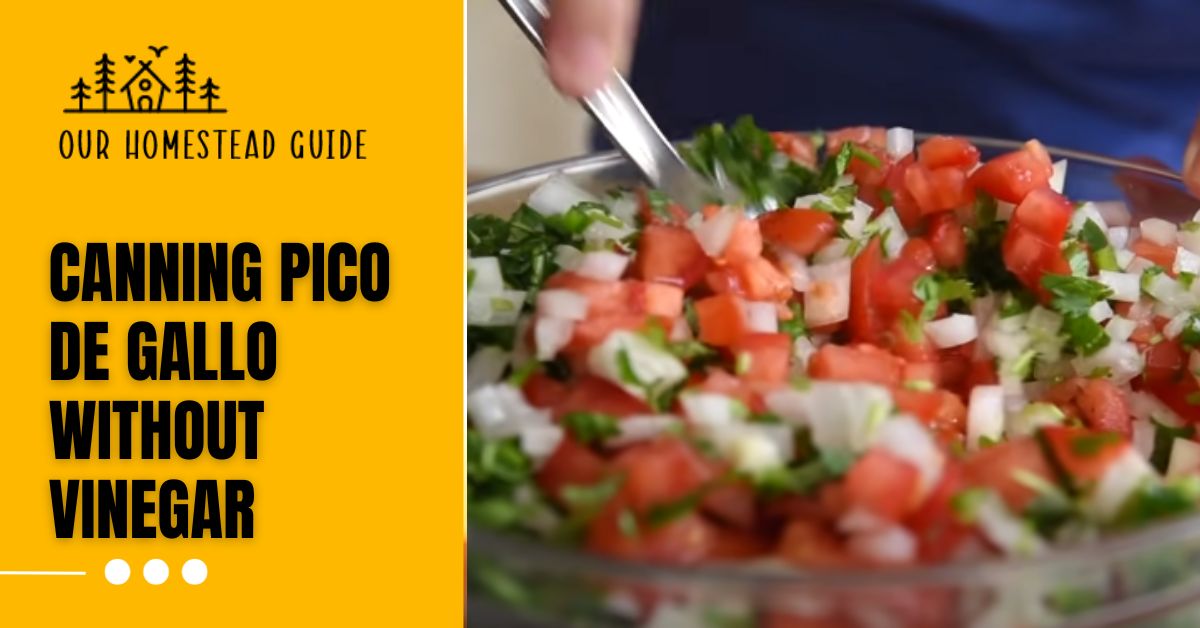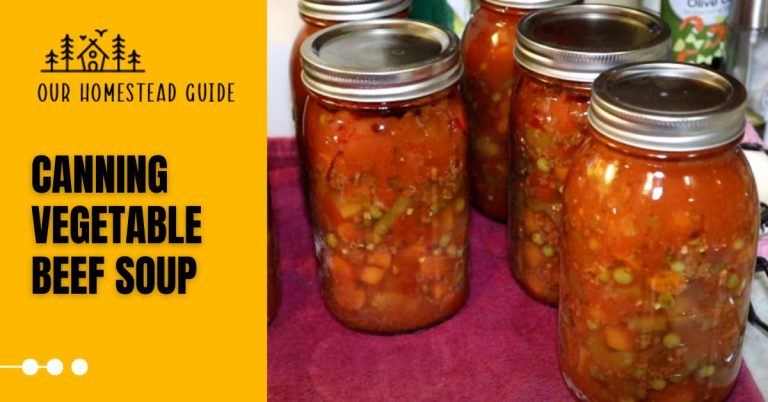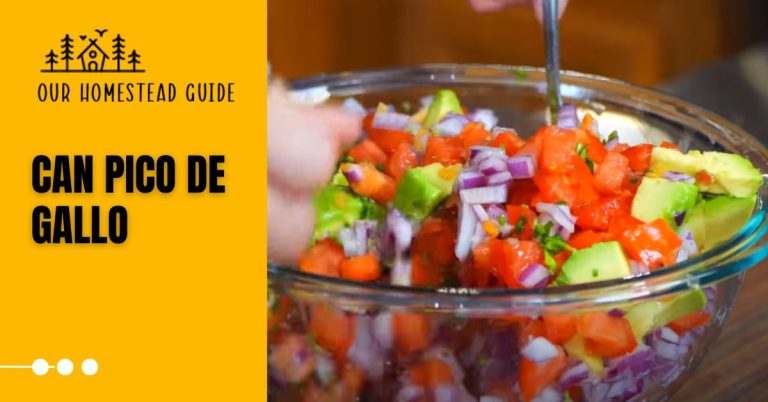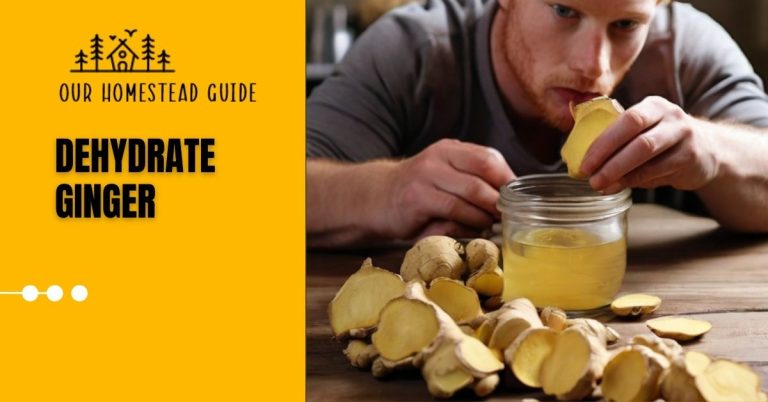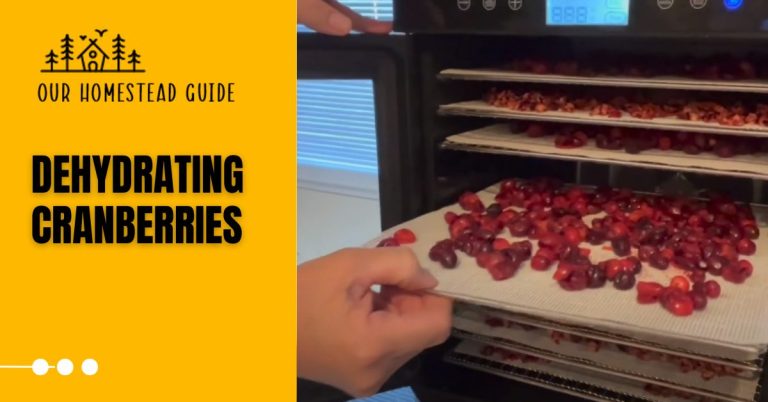Canning Pico de Gallo Without Vinegar: easy step by step guide
Canning Pico de Gallo Without Vinegar This vinegar-free pico de gallo canning procedure is a wonderful solution for savoring the taste of summer or sharing homemade presents. Canning pico de gallo without vinegar is a delicious method to preserve the flavor of garden-grown ingredients.
Without the tang of vinegar, this approach preserves the vivid flavors of ripe tomatoes, spicy peppers, and aromatic cilantro. By following a few simple steps, you can make jars of this popular Mexican salsa to enjoy all year.
Canning Pico de Gallo Without Vinegar
Ingredients:
- 6-8 diced ripe tomatoes
- 1 big coarsely chopped onion
- 2-3 jalapeno peppers, seeded and coarsely chopped (tune to the desired amount of heat)
- 1-2 minced garlic cloves
- 1/2 cup chopped fresh cilantro
- 2-3 limes juice
- Season with salt to taste
- Jars with lids and bands for canning
- Canner with boiling water or a large pot
- Lifter of jars
- The canning funnel
- Towels in the kitchen
Instructions:
How to Canning Pico de Gallo Without Vinegar?
1-Prepare Your Jars:
Canning Pico de Gallo Without Vinegar To begin the canning process, prepare your jars. Clean your canning jars, lids, and bands in hot, soapy water to remove any dirt or residue. Rinse them thoroughly to eliminate any soap residue, which might interfere with the canning process and impair the flavor of your pico de gallo.
Cleaning the jars properly is critical for storing the salsa safely and keeping it fresh. Keep the jars and lids warm after cleaning until you’re ready to fill them with the bright pico de gallo mixture.
2-Prepare Pico de Gallo:
Let’s get started on the pico de gallo itself. Combine the diced tomatoes, finely chopped onions, jalapeno peppers for a hint of spice, minced garlic for flavor, and fragrant cilantro in a large mixing dish. Canning Pico de Gallo Without Vinegar Make sure to fully combine these fresh ingredients, allowing their brilliant colors and different flavors to blend harmoniously.
This thoughtful blend is at the heart of your Canning Pico de Gallo Without Vinegar, offering a rush of freshness and flavor with each bite. This enticing combination will be the centerpiece of your homemade salsa, and as you can it, it will become a taste of summer preserved for year-round enjoyment.
3-Add Lime Juice and Salt:
It’s time to add a zesty edge to your pico de gallo to boost the flavors. Allow the fresh lime juice to infuse the salsa with brightness and a bit of tartness by squeezing it over the mixture. Remember to season with salt, depending on your unique taste preferences.
Not only does the salt enhance the flavors, but it also aids in the preservation of the salsa during the canning process. Canning Pico de Gallo Without Vinegar With a gentle whisk, distribute the lime juice and salt evenly throughout the pico de gallo, creating a beautiful balance of savory and tangy elements that will elevate your homemade salsa to new heights.
4-Sterilize Jars:
It is critical to sterilize the canning jars correctly to ensure the safety and longevity of your canned pico de gallo. To begin, place your canning jars in a boiling water canner or a large saucepan with a rack. Fill the jars with water, making sure they are thoroughly submerged. Bring the water to a gentle simmer and leave the jars to cook for around 10 minutes.
This procedure sterilizes the jars, removing any potential pathogens. Canning Pico de Gallo Without Vinegar Remember to keep the jars warm after sterilization because hot jars are vital for filling with your freshly prepared pico de gallo and guaranteeing a safe and effective canning process.
5-Fill the Jars:
Once your sterilized jars are ready, fill them with the bright pico de gallo mixture. Use a canning funnel to make this procedure nice and efficient. Gently spoon the prepared pico de gallo into each jar, leaving about 1/2 inch of headroom at the top. This headroom is necessary for achieving a proper seal during the canning process.
Canning Pico de Gallo Without Vinegar The canning funnel prevents spills and ensures that your jars are evenly filled, maintaining the salsa’s freshness and flavors for months to come.
6-Remove Air Bubbles:
To preserve the quality and lifespan of your canned pico de gallo, remove any trapped air bubbles from the jars. Use a clean, non-metallic implement, such as a plastic spatula or a chopstick, to do this. Insert the utensil gently along the inside of the jar, moving it in a circular motion to release any trapped air bubbles within the salsa.
This step is critical because trapped air can disrupt the canning process and lead to deterioration. Canning Pico de Gallo Without Vinegar, By removing these bubbles, you can ensure that your pico de gallo stays fresh and safe to eat during storage
7-Wipe Jar Rims:
It is critical to keep the canning process clean, and wiping the jar rims is an important step in achieving a proper seal. Gently wipe the rims of each jar with a moist kitchen towel or a clean cloth. Canning Pico de Gallo Without Vinegar, This thorough cleaning removes any debris, pico de gallo, or moisture that could interfere with the sealing procedure.
A clean and dry rim is required to form a tight seal that will keep your canned salsa fresh and safe for long-term preservation.
8-Apply Lids and Bands:
It’s time to seal the sweetness inside your sterilized canning jars after carefully filling them with your tasty preserves or pickles. Apply the sterilized canning lids to each jar’s mouth, making sure they fit snugly. Screw on the bands with your fingertips until they are fingertip tight. Remember that no undue force is required; a soft, secure closing is all that is required.
Overtightening may obstruct the natural venting mechanism during canning, so keep it snug. Canning Pico de Gallo Without Vinegar, Your homemade culinary delights are well on their way to being stored and enjoyed for many months to come with lids and bands in place.
9-Process in Boiling Water Bath:
Now that your filled jars are properly sealed with lids and bands, it’s time to preserve them using the tried-and-true method of a boiling water bath. Lower each jar carefully into the boiling water canner or a big saucepan filled with vigorously boiling water, making sure they are fully submerged and covered with at least 1-2 inches of water.
The magic happens during this critical step in the canning process. Canning Pico de Gallo Without Vinegar, Allow the jars to process in a hot water bath for 15-20 minutes. This guarantees that the contents are properly heated, effectively sealing the jars, and ensuring the long-term quality of your handcrafted treasures.
10-Remove and Cool:
When the processing in the boiling water bath is finished, carefully remove your jars. Use a jar lifter to gently remove the jars from the canner, being careful not to cause any abrupt jolts or motions that could compromise the sealing process. After removing the hot jars from the canner, lay them on a clean, dry kitchen towel or a cooling rack.
Patience is essential for successful canning here. Allow 12-24 hours for the jars to cool naturally and gradually. Canning Pico de Gallo Without Vinegar, This progressive cooling is critical for ensuring a proper seal and preserving the integrity of your homemade preserves or pickles.
11-check Seals:
Allow your freshly treated jars to cool for 12-24 hours before checking the seals to confirm the success of your canning attempt. Press down gently on the center of each lid. The lid of a sealed jar will not pop back when pressed. This indicates the formation of a vacuum seal, which seals in the taste and freshness of your preserved contents.
Canning Pico de Gallo Without Vinegar, If a lid does pop back when pressed, it means the jar did not seal properly during processing. Don’t worry; simply refrigerate and intend to consume the contents within a few days.
12-Store:
After you’ve successfully sealed your jars and properly refrigerated any unsealed ones, it’s time to locate them in a suitable location for storage. Choose a cold, dark spot in your pantry or cabinet for the sealed jars. These circumstances will enable your homemade preserves or pickles to keep their quality for up to a year, allowing you to relish your gourmet creations at your leisure.
Unsealed jars, on the other hand, should be refrigerated and their contents consumed within a few days to preserve freshness and safety. Canning Pico de Gallo Without Vinegar, You may enjoy the results of your canning labor throughout the seasons if you follow these storage instructions.
Table: Ingredient Measurements
| Ingredient | Quantity |
|---|---|
| Fresh tomatoes | 3 cups |
| Onions | 1 cup |
| Jalapeños | 2-3 |
| Cilantro | 1/2 cup |
| Lime juice | 1/4 cup |
| Salt | To taste |
| Garlic | 2 cloves |
Notes:
- Adjust spice levels by adding or reducing the number of jalapeños.
- Experiment with different varieties of tomatoes for unique flavors.
- Ensure jars are properly sealed to prevent spoilage.
Serving Ideas
There are still many of uses for this tasty condiment. Here are some vinegar-free serving suggestions for canned pico de gallo:
Enchilada Sauce:
The foundation of your enchilada sauce should be canned pico de gallo. Just puree the pico de gallo with a few more spices, such as oregano, chili powder, and cumin, and boil it until it gets a little thicker.
Verde Salsa:
Blend canned pico de gallo with tomatillos, roasted jalapeños, and cilantro to create a colorful salsa verde. Process all the ingredients in a blender until smooth, then taste and adjust the seasoning. This savory and tart salsa is great as a garnish for grilled chicken, burritos, and tacos.
Dip in Pico de Gallo:
Savor canned pico de gallo with grilled meats, veggies, or Mexican chips for a cool dip. Its zesty and fresh aromas will entice your palate and offer a nutritious snack choice.
The salad topper
Use canned pico de gallo to give your salads a taste and textural boost. Its chopped tomatoes, onions, cilantro, and lime add color and are a good source of vitamins to your salads.
Omelet Booster:
Improve the stuffing of your omelets by adding canned pico de gallo. The delicious tastes of the cheese, veggies, and meat in your omelet will be enhanced by its zesty and fresh undertones.
Garnish for Soup & Stews:
Canned pico de gallo adds a beautiful and delicious garnish to your soups and stews. Its flavor and vivid hues will provide a pleasant finishing touch.
Ceviche Supplement:
Add canned pico de gallo to your ceviche recipe for a tangy and refreshing twist. The tomatoes and onions in the pico de gallo will provide a little taste and texture, and the lime juice will help “cook” the fish.
Filling for Quesadillas:
Make your quesadillas more delicious by stuffing them with canned pico de gallo. Its tasty and fresh ingredients go well with the melted cheese and other toppings like veggies, chicken, or beans.
Addendum Nacho:
Serve your favorite toppings with canned pico de gallo to amp up your nachos. Its zesty and fresh flavors will counterbalance the cheese’s richness and provide a delicious contrast with the crispy tortilla chips.
Parts of the burrito bowl and tacos:
Use plenty of canned pico de gallo to jazz up your tacos and burrito bowls. Its flavorful, fresh tastes go well with rice, beans, and any protein you choose.
Benefits of Canning Pico de Gallo Without Vinegar
There might be some advantages to employing this technique:
Without Preservatives:
You may stop using a preservative in your canned pico de gallo by leaving out the vinegar. Those who like a more natural and preservative-free method of food preservation might find this appealing.
Modified Profile of Flavor:
The taste profile of pico de gallo will be somewhat altered in the absence of vinegar. Usually, the sweetness of tomatoes counteracts the acidity of vinegar to produce a pleasing taste balance. On the other hand, taking off the vinegar might make the pico de gallo a little sweeter.
Diminished Acidity:
Canning pico de gallo without vinegar could be a good choice for people who have sensitive stomachs or who want less acidic cuisine. The condiment’s overall acidity will be lowered in the absence of vinegar.
Adaptability in Gastronomic Uses:
Pico de gallo made without vinegar has a somewhat different taste profile and less acidity, which might lead to new culinary uses. It might be used, for example, in recipes where the flavor of vinegar would interfere with other components.
Remember that canning pico de gallo without vinegar is not regarded as a safe method. Vinegar’s acidity is essential for stopping the growth of dangerous bacteria that can result in botulism, a potentially deadly foodborne infection. The danger of botulism increases dramatically in the absence of vinegar.
Most Frequently Asked Questions!
1- Can I have Pico de Gallo without using vinegar?
Pico de Gallo can be canned without vinegar. To ensure safe canning, you can utilize different methods to acidify the mixture, such as lemon or lime juice.
2- Why is acidity important when Canning Pico de Gallo Without Vinegar?
Acidity is essential in canning because it prevents unwanted bacteria from growing and assures the safety of the preserved food. Typically, vinegar or citrus juice is used to acidify Pico de Gallo.
3- What alternatives can I use to vinegar for Canning Pico de Gallo Without Vinegar?
As an alternative to vinegar, you can acidify Pico de Gallo with lemon juice, lime juice, or citric acid. These settings give the acidity required to make the product suitable for canning.
4- How much lemon or lime juice should I use as a substitute for vinegar in Pico de Gallo?
As an alternative to vinegar, you can acidify Pico de Gallo with lemon juice, lime juice, or citric acid. These settings give the acidity required to make the product suitable for canning.
5- Can I use fresh lemon or lime juice instead of bottled juice for Canning Pico de Gallo Without Vinegar?
Fresh lemon or lime juice is not suggested for canning since the acidity varies and may not offer the essential degree of acidity for safe preservation. The acidity level in bottled juice is consistent.
6- Are there any safety precautions I should follow when canning Pico de Gallo without vinegar?
Yes, use clean jars and lids, process the jars in a boiling water bath or pressure canner according to approved periods and pressures, and ensure that the final product has a safe pH level.
7- Can I adjust the acidity level in Pico de Gallo to suit my taste?
While the acidity level can be adjusted somewhat to suit your taste, it is critical to maintain the minimum needed acidity for safe canning. To ensure safety, stick to tried-and-true recipes and rules.
8- Can I have Pico de Gallo without any acidification?
Canning Pico de Gallo without acidification is not recommended because it can lead to bacterial development and spoiling. When canning, always use an acidic component like as vinegar, lemon juice, or lime juice.
9- What is the shelf life of canned Pico de Gallo without vinegar?
When stored in a cold, dark, and dry environment, properly canned Pico de Gallo can have a shelf life of up to a year or longer. Before using the jars, inspect the seals for any signs of deterioration.
10- Can I safely Pico de Gallo without a pressure canner?
Yes, you can safely can Pico de Gallo without a pressure canner using a boiling water bath canning method; however, make sure to follow the suggested processing periods for your altitude and modify as needed.
you may also like this article.

